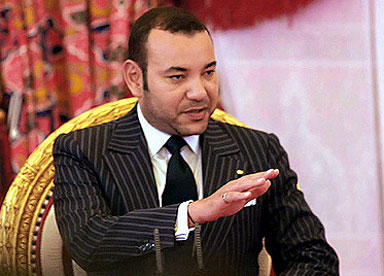Morocco: For Whom the Land?

During the global economic and financial downturn, Forbes magazine published the financial wealth of the world’s richest royals, reporting that the sole monarch in the western Arab world actually doubled his personal wealth over the previous five years. While the food and mortgage crises spread to local consumers the world over, Morocco’s Mohammed VI accumulated $1 billion in 2008 from the rising price of phosphate, the extraction of which mineral is mined by a Moroccan state monopoly under his possession.In the rank among royals, Mohammed IV came in seventh richest overall with a fortune estimated at 2.5 billion dollars, six times the treasures accumulated by either the Qatari or Kuwaiti monarchs.
The Moroccan king has been described as his country’s principle banker, insurer, exporter and cultivator, controlling the production and distribution of energy and food, as well as much of the communication sector. That moniker follows his 1999 enthronement as the touted “king of the poor.”
The State of Morocco pays the king’s salary of $40,000 per month, while the annual public fund allocated to “the king and his court” is estimated at $31 million. By comparison, the cost to Moroccans to sustain their head of state is 18 times the cost of maintaining Queen Elizabeth II. In proportion to their relative GDPs, Moroccans pay their king 60 times what the French dole out to fund their head of state. In local terms, the annual budget of the palace at 2.58 billion dirhams (€258 million) exceeds the combined budgets of four Moroccan ministries: Transportation and Public Works, Justice and Freedom, Culture, and Agriculture and Fisheries. One calculation equates the king’s official budget with that of 375,000 average Moroccan citizens.
However, this is only the tip of the acquisitive iceberg. Already in the 1980s, the previous King Hasan II “liberalized” the economy with a privatization program that enabled the king personally to acquire the choicest public enterprises through Omniumnordeafrique (ONA). That company, first started in 1934 as a function of the French colonial administration, was acquired by Hasan II in 1980.
Today’s royal ONA holding company contains dozens of subsidiaries in most strategic sectors of the Moroccan economy. Key among these are the food sector (production, processing, distribution and export), related land and real estate, housing, mining and, of course, banking. While these companies were officially privatized in favor of the monarch, they continue to tap into the state budget by receiving subsidies that ensure their expansion with huge profits that further enrich the royal family.
Between 1981 and1985, ONAmultipliedits salesvolumeseven fold, with 72% of the activities carried out in agro-food enterprises. ONA’s holdings include companies like Cosumar, which holds a monopoly on sugar, and the Central Dairy plant, with its monopoly on milk products, and Lesieur Cristal (oils and soaps). These royal companies operate in markets in which the state subsidizes their products.
In a country where three quarters of its farmers eke out a living on less than five hectares, the king’s massive land holdings allow the king not only to enrich himself with disproportionate advantage, but also to distort the agricultural system and sector. The land administration in Morocco suffers from some of the same distortions that afflict the entire region. There the land information system is opaque and geared to conceal the facts of who actually owns much of the country’s land.
Official data can be misleading. In fact, some 400–450,000 hectares (4–4,500 km2) disappeared from the land registry at independence in 1956, and even after the “moroccanization” of former colonial lands in 1970. Assumptions have pointed to a royal “land grab,” See (Graciet and Laurent: p.45) but the lack of a transparent land-information system obscures the record.
|